Dogwood - what is this plant and how to grow it?
Dogwood - what is this shrub? How to grow it correctly on the site? How are its fruits useful? Many people are looking for answers to these questions.
Content:
- Features of the structure of the bush
- Growing conditions
- Landing conditions and rules
- Care advice
- Possible growing problems
- Composition and useful properties of dogwood
Features of the structure of the bush
Dogwood is a low shrub that grows more in breadth than in height. Its height is up to 2.5-3 m.When growing a dogwood in the form of a tree, its height reaches 5 m, but the trunk varies from 5 cm in diameter to 40 cm. Growing a tree is somewhat more difficult than a shrub, but it is easy to form: initially by eliminating all root shoots, and in the future, simply trim the shoots from the lateral buds.
The fruit shrub is not afraid of severe frosts, it calmly withstands a decrease in temperature to -35 C. Therefore, it can easily get along in northern latitudes. The only drawback is its long fruit ripening. Flowering lasts an average of 1 month. Flowering begins from mid-March to the second decade of April. If the air temperature rises above +5 .. + 10 C, then such conditions are favorable for a full-fledged budding process.
Flowers begin to bloom on bare branches in the absence of leaf blades. One gets the feeling that the bush is standing in a yellow cloud of bright buds. Pollination is done through the work of bees and the wind. Pollination is negatively affected by unfavorable weather conditions: rain and fog. But the length of the budding period allows the plant to be fully loaded with the crop. The fruits ripen for at least 2-3 months.
Therefore, experienced gardeners recommend purchasing early types of dogwood so that the fruits have time to ripen in time. The yield of one adult bush can vary from 8 kg to 240-250 kg. The amount of berries harvested depends on the time of flowering and the usefulness of pollination of the buds.
Fruits, depending on the variety, have different colors: red, yellow, purple and even black.
In appearance, they have a cylindrical oblong shape, they are also epileptic, pear-shaped or completely rounded. The weight of one berry can range from 2.5 grams to 12 grams.
Dogwood for normal pollination is required to be planted on the backyard by pollinators. Other gardeners argue that the plant does not require additional shrubs, it is able to pollinate on its own and give a crop. But at the same time, it is noted that such varieties of varieties in most cases give a low yield. Cross-pollination remains a backup option for planting if the whole month of flowering has not been given favorable sunny weather.
Growing conditions
Cornel can grow on any soil, but soils with a neutral or alkaline pH environment are more suitable for favorable cultivation. Lime and manganese become the best components of the soil substrate for the plant.If the last ingredient is not present in the soil, then it is recommended to apply it during periodic feeding.
It is not recommended to plant a bush in lowlands or in places where groundwater is close to the surface of the earth. Do not plant in an area where underground moisture is higher than 1.5 meters underground. If there are no other options for planting a dogwood sprout, then it is recommended to make a good drainage layer or raise the surface of the earth. The shrub does not tolerate close proximity, it needs space. Therefore, at a distance of 1.5-2 meters from it, there should be no fences, no buildings, or other fruit and berry crops. This is due not only to tightness, but also to the need for nutrient moisture and feeding, which can be absorbed by the massive roots of adult neighbors.
Thanks to good placement, dogwood can live a long life of 100 years or more and bear fruit regularly.
If you plant a plant in partial shade, then the bush will grow, also bear fruit, but over time its stems will be thinner, and the fruits are smaller and fewer in number. If you place a plant next to a garden plot with other trees, then it is recommended to do this from the north side. This is due to the fact that on a hot sultry day at noon, a massive tree with its shadow will block young shrubs from the sun.
Otherwise, it is recommended to shade the plant in the open area in the first few years of the development of young growth. The process is carried out by installing pillars, on which a canvas is stretched, which protects from the baking rays of the luminary.
Landing conditions and rules
If planting is planned, then about 6 months in advance, it is required to dig up the soil 45-60 cm deep. In this case, it is necessary to remove all garbage in the selected area, choose root system other plants, as well as weeds that have settled on the site. After that, organic and mineral fertilizers... Up to 6 kg of rotted manure is poured onto 1 m2. In early autumn, green manures are planted on this territory. Such plants include winter cereals, peas.
In the spring, a similar procedure is also carried out, but a phacelia or vetch is already placed. After the flowering of such herbs, the plant, along with the rhizome and stem, is dug up and buried in the ground on the bayonet of a shovel. Plants of this kind allow you to saturate the soil with nutrients necessary for rapid growth and high-quality development.
The optimal planting option is rooting a prepared seedling in the autumn period 30-45 days before the onset of the first frost.
Also, the plant can be planted in the spring, but this requires preparing a place in advance in the fall: digging up the soil and adding nutrients. Such a procedure is carried out in advance so that the soil substrate has time to settle and be saturated with vitamins and microelements. Planting is carried out at the time of the onset of the first spring days, marked by heat. It is required to carry out an event before swelling and cracking of the buds on the dogwood. In the south of Russia, in the Crimea and the Kuban, the landing is made in mid-February or early March, and in the central ones - starting from the second half of March.
To select a quality seedling, you should contact the nursery. Best suited for planting are two-year-old sprouts that reach a height of 1.5 m. Such seedlings should have a good trunk up to 2 cm in diameter and at least 4-5 well-developed branches. It is advisable to buy varieties that are zoned for the region in which the gardener lives. So the bush does not have to adapt to new living conditions.
In addition to the general view, the following issues should be carefully monitored at the time of purchase:
- The rhizomes should not show signs of disease or rot.
- It is better to purchase those seedlings that have 2 or 3 root branches, each of which is at least 25 cm in length.
- When buying, you should pay attention to the conditions in which the roots were kept - they must be moist. If the root system is weathered, then this indicates a long stay of the seedling in the open air and the long-standing extraction of the seedling from the soil. Such conditions of detention negatively affect the development of the seedling, if it can grow at all in the future.
- The bark on the seedling should be straight, like on a healthy, full-fledged tree. A shriveled and dark bark indicates inadequate housing conditions.
Before buying, you need to slightly pry the trunk and expose the lower bark. If it has a green tint, then the seedling is alive. Otherwise, with a brown tint, you should not acquire this kind of stalk: it will not grow. When transporting a seedling, open rhizomes are pre-wrapped with a wet cloth, and a plastic bag is placed on top.
Features of planting a seedling:
- Before planting work, if they are carried out in the autumn months, it is necessary to carefully remove the leaf plates, cut the broken and damaged branches with a clean garden tool.
- At the time of planting, a groove should be dug in the prepared area no less than the rhizomes of the plant. A pit is ideal, which will be at least 60-80 cm wide and up to 80 cm deep. Such volumes are necessary so that the root system of the bush can easily and correctly position itself on the surface of the recess.
- First of all, a drainage layer is located on the bottom of the recess. The latter should not be less than 10-12 cm. Expanded clay, gravel or sea pebbles are ideal for this.
- Nutrients are laid out in the hole: humus, ammonium nitrate, wood ash and superphosphate. All components are first mixed with the earth, which was removed from the planting pit. Only after obtaining a high-quality batch, fertile soil is placed in the hole, filling it to the middle, but so that a small mound forms on top.
- If the root system managed to dry out during the preparation of the hole, then the seedling must be laid out in a liquid with a root growth stimulator to saturate it with moisture. Additionally, it is worth removing all dried roots to a healthy area and sprinkle with activated carbon.
- A plant is installed on this elevation, and the rhizomes are gently straightened. After that, everything is covered with soil substrate, but so that hollow holes do not form at the base of the rhizomes, water will then stagnate in them, provoking rotting and pathogenic bacteria.
After rooting, the ground at the base is carefully tamped and shed well with water. Be sure to cut off the branches by 2/3 of the total volume of the planted shrub. This is necessary in order to equalize the ratio of the aboveground part and the root system.
Care advice
Proper plant care should be carried out based on several requirements:
- The first measures for the care of the seedling are carried out at the moment when the first spring days come - loosening and removal of weeds that have managed to grow during the period of development of the shrub are carried out. The procedure is carried out 5 more times during the growing season, as well as after harvest. After each process carried out, it is required to carry out mulching... Straw is used as mulch.
- Watering is carried out often, due to the fact that the dogwood is a moisture-loving plant. To do this, you can pour moisture into a recess specially dug around the perimeter, or introduce nutritious moisture into holes dug out in several places near the base of the trunk. This is required so that the water does not spread throughout the entire site, but only the dogwood flows.
- Top dressing is periodically applied. It is required for quality growth, good flowering and the formation of large berries. For this, ammonium nitrate and humus are placed under the root.Initially, in the first days of spring, it is required to pour 1 bucket of water under the tree with a fresh mullein diluted in it, or bird droppings... It is required to observe the proportions of 1: 5 and 1:10, respectively. Many gardeners use agrolife as a top dressing. In the last days of August, it is recommended to add 0.5 liters. water with wood ash diluted in it. And after harvesting, to prepare the shrub for wintering, it should be fed with superphosphate fertilizers in the amount of 0.1 kg per bush.
- The plant does not require special pruning. It is recommended only when necessary to carry out sanitary pruning and anti-aging.
Possible growing problems
Cornel, in most cases, is not affected by diseases or pests. But, in spite of this information, the gardener must constantly monitor his own plantings and monitor the condition of the seedling:
- Sometimes on the leaf plates of young seedlings occurs powdery mildew... To fix the problem, it is enough to process systemic fungicide planting 2 times, but with a frequency of 7-10 days.
- If you do not prune dry shoots in time, then there is a possibility of developing fungal diseases. Therefore, the removal of excess shoots that froze in winter or were damaged in summer is mandatory.
- In some cases, yellow spots resembling rust appear on the leaf plates. To eliminate them, dilute the consistency of Bordeaux liquid. Leaves that were damaged or fell on their own, in order to prevent further spread of the disease, must be burned or taken away from the personal plot.
Pests also rarely inhabit dogwood. Sometimes a worm can settle on the branches. To neutralize it, spray the shrub with a solution of lime. In addition to pests and diseases, the plant should be constantly watered. In the absence of the introduction of nutrient moisture, the leaf plates dry up and fall off, and not ripe fruits crumble, and not having time to ripen.
Composition and useful properties of dogwood
Each berry is rich in nutrients. It contains such useful components as glucose, fructose, essential oil, organic acids, phytancides, ascorbic acid and vitamin PP.
The berries are recommended for people who suffer from gout, dysentery, problems with the digestive tract, typhoid, anemia, as well as skin diseases and joint problems. With prolonged use of berries, a positive effect is felt.
Berries have the following effect on the patient's body:
- Diuretic
- Antipyretic
- Choleretic
- Antiscorbutic
- Anti-inflammatory
Additionally, pectin is found in dogwood fruits, which helps to remove harmful and toxic substances from the body. The composition helps to normalize blood pressure and normalize a person's condition in a hypertensive crisis, eliminate headaches and stabilize the pressure that occurs inside the head.
In addition, the constant use of fruits allows you to strengthen the walls of blood capillaries, increase their elasticity.
The beneficial effect is expressed in venous insufficiency and the pathological process of the veins. Daily use of dogwood berries removes excess fluid from the body, preventing the appearance of swelling of the legs after a hard day.
Thus, dogwood is a plant that gives not only tasty sweet and sour fruits, but also has a healing effect. For planting on the site itself, you should choose the right seedling and adhere to the planting rules.
More information can be found in the video:



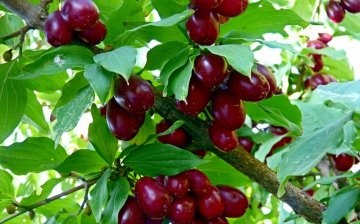
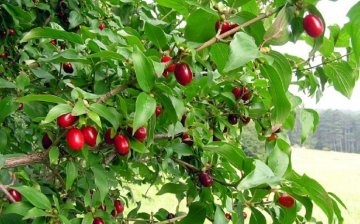
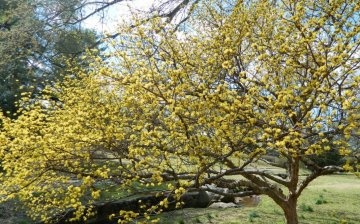
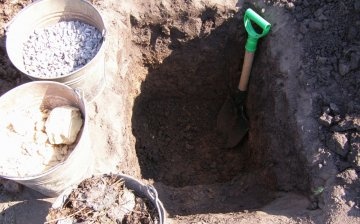
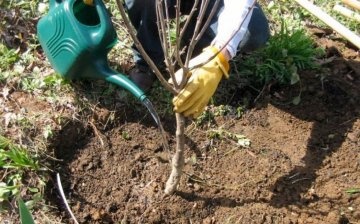
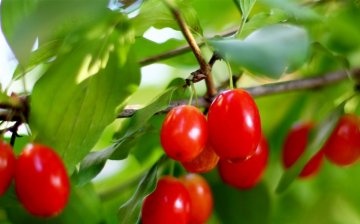
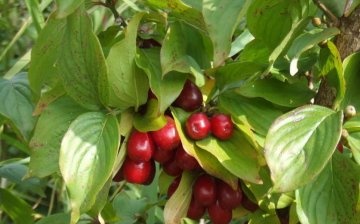









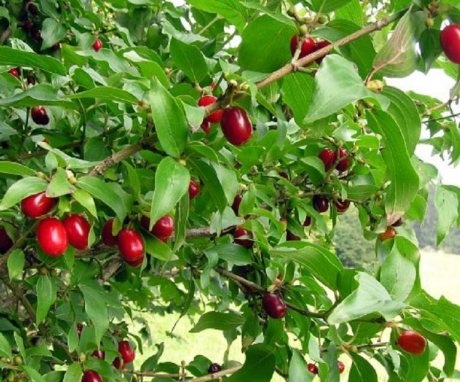
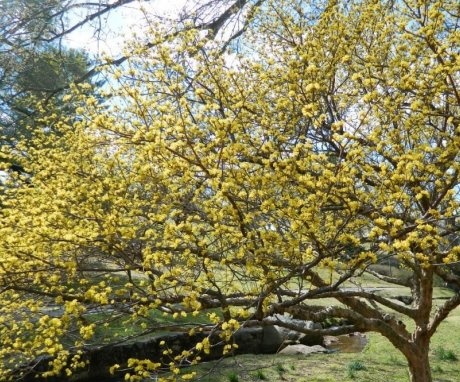
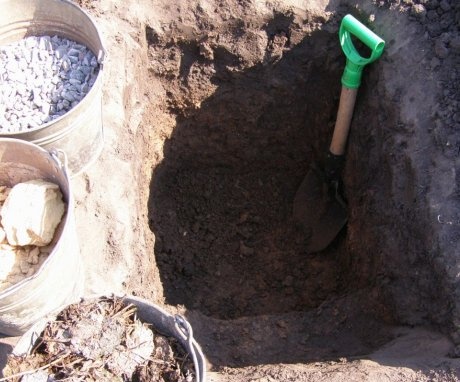
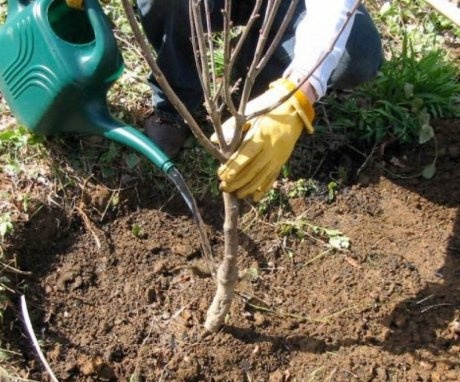
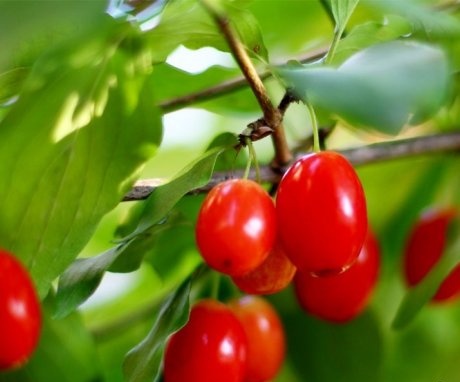
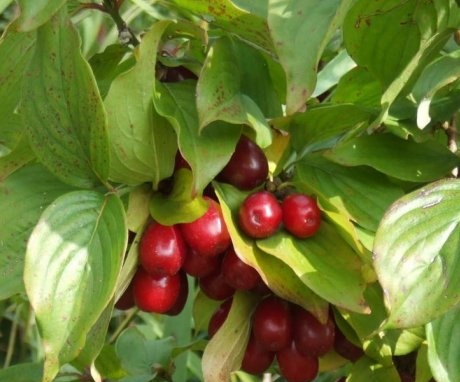
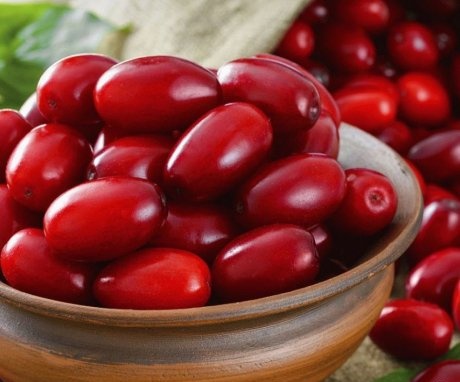
For the first time I tried dogwood in the form of jam when I was a student, the girl studied with us from Alma-Ata, so she treated us. It seems to me that in the northern latitudes, he still does not have time to ripen.
In middle latitudes, it ripens perfectly, although probably our dogwood is zoned. But in the northern latitudes, most likely, he will not be able to mature. But you can just plant it as an ornamental shrub.
I have a dogwood growing not very long ago. I love him very much, so I always dreamed of him in my garden. For the first time I saw a bush in the south, when I was vacationing at the sea. It makes jam especially tasty. He is not whimsical in leaving.